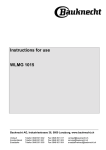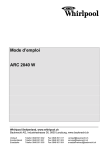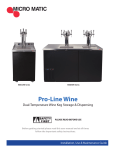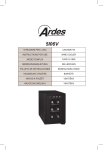Download Bauknecht WLMG 1010 Troubleshooting guide
Transcript
Instructions for use WLMG 1010 Bauknecht AG, Industriestrasse 36, 5600 Lenzburg, www.bauknecht.ch Verkauf Kundendienst Ersatzteile Telefon 0848 801 002 Telefon 0848 801 001 Telefon 0848 801 005 Fax 0848 801 017 Fax 0848 801 003 Fax 0848 801 004 [email protected] [email protected] [email protected] 41133001GB.fm Page 12 Thursday, October 28, 2004 12:07 PM INSTRUCTIONS FOR USE BEFORE USING YOUR WINE CELLAR SAFEGUARDING THE ENVIRONMENT PRECAUTIONS AND GENERAL RECOMMENDATIONS INTRODUCTION TO WINE HOW TO USE THE WINE CELLAR CARE AND MAINTENANCE TROUBLESHOOTING GUIDE AFTER-SALES SERVICE INSTALLATION ELECTRICAL CONNECTION 12 41133001GB.fm Page 13 Thursday, October 28, 2004 12:07 PM BEFORE USING YOUR WINE CELLAR The appliance you have purchased is a wine cellar (or wine-cooler), a professional product designed exclusively for storing wine. To get the most out of your new appliance, read the user instructions thoroughly. They describe the appliance in full and provide useful wine storage tips. Keep this handbook for future consultation. 1. After unpacking the appliance, make sure that the door shuts properly. Any damage must be reported to your dealer within 24 hours after delivery of the appliance. 2. Wait at least two hours before connecting the appliance to the power supply in order to ensure the refrigerant circuit is fully efficient. 3. Installation of the appliance and electrical connections must be carried out by a qualified electrician, in accordance with the manufacturer's instructions and local regulations. SAFEGUARDING THE ENVIRONMENT 1. Packing The packaging material is entirely recyclable, and marked with the recycling symbol. Follow local regulations for scrapping. Keep the packaging materials (plastic bags, polystyrene parts, etc.) out of reach of children, as they are potentially dangerous. 2. Appliance The appliance is made using recyclable materials. Disposal must be carried out in accordance with local environmental regulations for waste disposal. Make the appliance unusable by cutting off the power cord. The appliance must be delivered to an authorised collection centre for the recovery of refrigerant gas. Information: This appliance does not contain CFCs (replaced with R134a) or HFCs (replaced with R600a Isobutane). For more information, refer to the identification data plate affixed to the appliance. 13 41133001GB.fm Page 14 Thursday, October 28, 2004 12:07 PM PRECAUTIONS AND GENERAL RECOMMENDATIONS • The wine cellar must be used solely and exclusively for storing wine; do not place any type of food inside it. • Do not cover or obstruct the air vents of the appliance. • Do not allow children to play or hide inside the appliance - risk of becoming trapped and suffocating. • Before servicing or cleaning the appliance, unplug it from the mains or disconnect the electrical power supply. • The power cable may only be replaced by an authorised person. Information Appliances with Isobutane (R600a) Isobutane is a natural gas with low environmental impact. Caution is required, however, since isobutane is flammable. Therefore, it is essential to ensure that refrigerant pipelines are not damaged. Important: • If a large number of bottles are placed in the cellar at the one time, it may take a few days before a constant temperature is reached. • Important! Storage temperature must never drop below +6 °C • When in operation, water droplets and frost form on the walls of the cellar. These are part of normal operation. You don't have to remove the frost or dry the water droplets. The rear wall is defrosted automatically. The defrost water is automatically routed to a drain outlet and into a container from which it evaporates. 14 • The bottles can be neatly stored on the wooden racks. Each rack should not be used to hold more than 40 Kg. Bottle arrangement tips • Place the bottles in the middle of the rack. • On closing the door, make sure the bottles don't touch the glass. • Important: spirits and liqueurs should be airtight and stored in the upright position. • Do not use the appliance to store explosive substances. • The temperature may vary in different areas inside the appliance due to the circulating air: it is colder closest to the rear wall and warmer beside the glass door. • Remove bottles from packaging, do not store them inside crates or boxes. • Maximum holding capacities for classic 0.75l bordolese bottles are as follows: h 1400 mm holds 111 bottles, h 1600 mm holds 131 bottles. • Recommended holding capacities for classic 0.75 l Bordolese bottles are as follows: h 1400 mm holds 88 bottles, h 1600 mm holds 101 bottles. In any event, the h 1400 structure is capable of holding up to 111 bottles and h 1600 up to 131 bottles (Bordolese bottles). 41133001GB.fm Page 15 Thursday, October 28, 2004 12:07 PM INTRODUCTION TO WINE Wine storage A well-known characteristic of wine is that it can be stored over time: in the correct location, white wines can be stored for about two years after their vintage although ideally they should be drunk within one year. While light red wines can be stored for up to two years, full-bodied reds will age well for 10 years and dessert wines even up to twenty years. When you buy a bottle of wine, transfer it to your wine cellar or other suitable place immediately. There are three main factors that weigh on the process from grape cultivation to harvesting and fermentation: light, humidity and ambient temperature. To ensure the taste of the wine matures to its peak and the aroma remains unaltered, it must be stored with the right interaction of these three factors. arranged at liberty by place of origin, type of wine, area of production, winery or vintage, using the catalogue labels provided if desired. Arranging the bottles so that they can be easily identified and selected prevents any accidental jolts which, like vibrations, can unsettle sediments and alter the visual appearance of the wine for some time. Hence, try to move your bottles as little as possible, allowing the wine to rest. Furthermore, don't push the bottles so far back that they rest against the rear wall of the cellar as this would not only interfere with the automatic defrosting function, the water droplets collected during defrosting could also ruin the bottle labels. Bottle racks must be made from wood as this effectively absorbs any vibrations and keeps bottles away from the wall transmitting heat or cold. In addition, the bottles of wine must be stored away from substances or places with strong odours which can be easily absorbed by the wine. To this end, your new appliance has an active carbon filter to absorb any impurities in the air. Temperature and humidity Storage location Not everyone has a basement suitable for use as a cellar. Technology has only recently come up with an effective substitute for a natural cellar. Your new wine cellar is a special appliance designed specifically to hold and store wines properly. Indeed, it should only be used for your favourite bottles of wine, not for fruit, vegetables and tins. In this way, you can store and age any kind of wine properly even if you don't have a natural wine cellar. Temperature is a critical and vital factor during the entire life cycle of wine; it determines how well the wine develops when matured in the bottle. To ensure optimal storage, the temperature must be kept constant from 8 to 12 °C. Rapid, wide temperature swings must be avoided: when the temperature is too high, the liquids dilate accelerating the ageing process whereas excessively low temperatures (below 4 - 5 °C) can cause the precipitation of tartrates; such an imperfection would impair the pleasant appearance of the wine. In the extreme event that the temperature drops below 0 °C, the wine would freeze causing the cork to explode. Humidity is also crucial in optimal wine storage: dry environments cause the cork to shrink whereas overly damp locations cause mould and harmful microorganisms to form. Humidity must be kept between 50% - 70%. The cork This is an essential part of the bottle: the quality of the cork, selected by the wine-maker, is very important in the ageing process of the wine itself. The conditions of the cork, including corks in bottled wine, depend solely on the process and storage standards used by the manufacturer or bottler. How to store wine When storing your wine bottles, one golden rule not to be overlooked is that they must be laid horizontally or at an angle to ensure the wine keeps the cork wet. Some say that this causes the classic smell of “cork” in wine. In actual fact, keeping the cork in contact with the wine enhances its elasticity thereby guaranteeing its continued effectiveness. Another important factor in storing wine is how the bottles are arranged: the bottles should be 15 41133001GB.fm Page 16 Thursday, October 28, 2004 12:07 PM HOW TO USE THE WINE CELLAR Switching on the appliance Starting up the appliance All controls are on the outside of the appliance. Plug in the appliance to start it running and set the thermostat (Figure A1) to the required temperature; a green indicator light will come on (Figure A2) showing the appliance is on. An interior light (Figure B1) comes on automatically when the door is opened or can be switched on as required from the control panel (Figure A3). When faulty or broken, request a replacement from our authorized personnel (After-sales Service) Thermometer (Figure B2): A digital thermometer is provided along with the appliance and can be found inside the bag with the advertising materials. When attached to one of the wooden racks inside the cellar, the thermometer will display the interior temperature. The thermometer itself has a button cell battery which must be replaced when necessary. Adjusting the temperature 1. To ensure the appliance functions correctly, set the thermostat as explained in section “Introduction to wine” (page 15). 2. To adjust the temperature in the compartment, turn the thermostat control knob: • to MIN for the LEAST COLD internal temperature; • to MED for a MEDIUM temperature; • to MAX for the COLDEST temperature. Thermostat setting on z: appliance functions and interior light have been interrupted but the the cellar is still powered on. Note: Ambient air temperature, frequency of door opening and the position of the appliance can affect internal temperatures. These factors must be taken into account when setting the thermostat. 16 41133001GB.fm Page 17 Thursday, October 28, 2004 12:07 PM CARE AND MAINTENANCE Before any cleaning or maintenance operation, unplug the appliance from the mains or disconnect the electrical power supply. The wine cellar has a fully automatic defrosting function. • Droplets of water on the rear wall of the appliance indicate that the periodic automatic defrost cycle is in progress. The defrost water is automatically routed to a drain outlet and into a container from which it evaporates. • Clean the defrost water drain outlet regularly using the tool supplied with the appliance in order to ensure defrost water is removed correctly. • Clean the condenser at the rear of the appliance regularly with a vacuum cleaner or a brush. If necessary... 1. Empty the wine cellar. 2. Disconnect the appliance from the power supply. 3. Leave the door partly open (approx. 3-4mm) to prevent the formation of mould, unpleasant odours and oxidation. 4. Clean the appliance. • Clean the inside regularly with a sponge dampened in warm water and/or neutral detergent. Rinse and dry with a soft cloth. Do not use abrasive products. • Clean the outside with a damp cloth. Do not use abrasive products, scourers, stain-removers (e.g. acetone, trichloroethylene) or vinegar. • Clean the outside of the glass with a standard glass-cleaning detergent but with a damp cloth only on the inside to prevent detergents from interfering with the proper storage of the wine. Active carbons In addition to temperature, air quality is also vital in wine storage. The active carbon filter is essential in filtering the external air, thereby assuring an adequate supply of clean air, free of dust and odours (Figure C1). Replacement filters are available and can be requested from the After-sales Service. Rack cleaning Use a damp cloth to clean the oak racks. Be careful not to damage the rubber seal when removing the rack from the appliance. To that end, open the door fully. 17 41133001GB.fm Page 18 Thursday, October 28, 2004 12:07 PM TROUBLESHOOTING GUIDE 1. The appliance is not working. •Is there a power failure? •Is the plug properly inserted in the socket? •Is the double-pole mains switch on? •Has the fuse blown? •Is the power cord damaged? •Is the thermostat set to z (Stop)? 2. The internal temperature is not low enough. •Is the door shut properly? •Are the bottles preventing the door from closing properly? •Is the appliance installed near a heat source? •Is the thermostat setting correct? •Are the air circulation vents blocked? 3. The temperature inside the wine cellar is too low. •Is the thermostat setting correct? 4. The appliance is excessively noisy. •Has the appliance been installed correctly? •Are the pipes at the back touching or vibrating? 5. Water collects at the bottom of the cellar. •Is the defrost water drain blocked? Notes: Gurgling and hissing noises due to expansion in the refrigerant circuit are normal. AFTER-SALES SERVICE Before contacting the After-sales Service: 1. check first if you can solve the problem by yourself (see “Troubleshooting guide”). 2. Switch the appliance on again to see if the problem recurs. If it does, disconnect the appliance from the power supply and wait for about an hour before switching it on again. 3. If the problem persists after this course of action, contact After-sales Service. Specify: •the nature of the problem, •the model, •the Service number (the number after the word SERVICE on the data plate on the inside of the appliance), •your full address, •your telephone number and area code. Note: The direction of door opening can be changed. If this operation is performed by After-sales Service it is not covered by the warranty. 18 41133001GB.fm Page 19 Thursday, October 28, 2004 12:07 PM INSTALLATION • Install the appliance away from heat sources. Installation in a hot environment, direct exposure to the sun or installation near heat sources (heaters, radiators, cookers) will increase power consumption and should therefore be avoided. • If this is not possible, the following minimum distances must be respected: •30 cm from coal or paraffin stoves; •3 cm from electric and/or gas stoves. • Fit the spacers on the rear of the condenser at the back of the appliance (see figure). • To optimize appliance efficiency, leave a 5 cm gap above the appliance and make sure that adjacent kitchen units are sufficiently distanced to allow air circulation. • Install the appliance in a dry, well-ventilated place, and ensure it is level, using the front adjustment feet if necessary. • Clean the interior. • Fit the accessories. Electrical Connection • Electrical connections must be made in accordance with local regulations. • Voltage and power consumption are indicated on the rating plate inside the appliance. • Regulations require that the appliance is earthed. The manufacturer declines all liability for injury to persons or animals and for damage to property resulting from failure to observe the above procedures and reminders. • If the plug and socket are not of the same type, have the socket replaced by a qualified electrician. • Do not use extension leads or adapters. Disconnecting the appliance It must be possible to disconnect the appliance by unplugging it or by means of a two-pole switch fitted upline of the socket. 19 41133001GB.fm Page 20 Thursday, October 28, 2004 12:07 PM ELECTRICAL CONNECTION For Great Britain only Warning - this appliance must be earthed Fuse replacement If the mains lead of this appliance is fitted with a BS 1363A 13amp fused plug, to change a fuse in this type of plug use an A.S.T.A. approved fuse to BS 1362 type and proceed as follows: 1. Remove the fuse cover (A) and fuse (B). 2. Fit replacement 13A fuse into fuse cover. 3. Refit both into plug. Important: The fuse cover must be refitted when changing a fuse and if the fuse cover is lost the plug must not be used until a correct replacement is fitted. Correct replacement are identified by the colour insert or the colour embossed in words on the base of the plug. Replacement fuse covers are available from your local electrical store. For the Republic of Ireland only The information given in respect of Great Britain will frequently apply, but a third type of plug and socket is also used, the 2-pin, side earth type. Socket outlet / plug (valid for both countries) If the fitted plug is not suitable for your socket outlet, Please contact Whirlpool Service for further instruction. Please do not attempt to change plug yourself. This procedure needs to be carried out by a qualified Whirlpool technician in compliance with the manufactures instructions and current standard safety regulations. 20



















